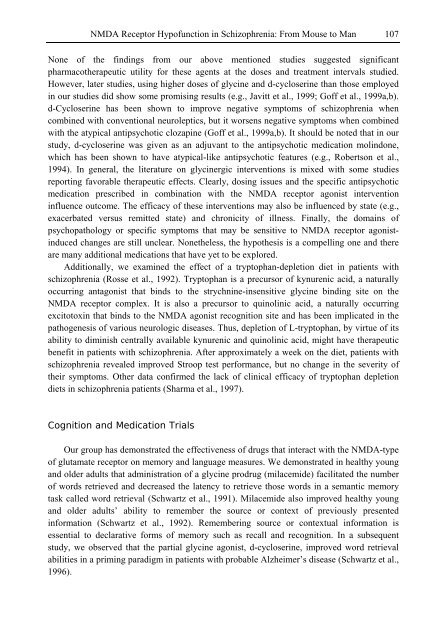Schizophrenia Research Trends
Schizophrenia Research Trends
Schizophrenia Research Trends
- No tags were found...
You also want an ePaper? Increase the reach of your titles
YUMPU automatically turns print PDFs into web optimized ePapers that Google loves.
NMDA Receptor Hypofunction in <strong>Schizophrenia</strong>: From Mouse to Man 107None of the findings from our above mentioned studies suggested significantpharmacotherapeutic utility for these agents at the doses and treatment intervals studied.However, later studies, using higher doses of glycine and d-cycloserine than those employedin our studies did show some promising results (e.g., Javitt et al., 1999; Goff et al., 1999a,b).d-Cycloserine has been shown to improve negative symptoms of schizophrenia whencombined with conventional neuroleptics, but it worsens negative symptoms when combinedwith the atypical antipsychotic clozapine (Goff et al., 1999a,b). It should be noted that in ourstudy, d-cycloserine was given as an adjuvant to the antipsychotic medication molindone,which has been shown to have atypical-like antipsychotic features (e.g., Robertson et al.,1994). In general, the literature on glycinergic interventions is mixed with some studiesreporting favorable therapeutic effects. Clearly, dosing issues and the specific antipsychoticmedication prescribed in combination with the NMDA receptor agonist interventioninfluence outcome. The efficacy of these interventions may also be influenced by state (e.g.,exacerbated versus remitted state) and chronicity of illness. Finally, the domains ofpsychopathology or specific symptoms that may be sensitive to NMDA receptor agonistinducedchanges are still unclear. Nonetheless, the hypothesis is a compelling one and thereare many additional medications that have yet to be explored.Additionally, we examined the effect of a tryptophan-depletion diet in patients withschizophrenia (Rosse et al., 1992). Tryptophan is a precursor of kynurenic acid, a naturallyoccurring antagonist that binds to the strychnine-insensitive glycine binding site on theNMDA receptor complex. It is also a precursor to quinolinic acid, a naturally occurringexcitotoxin that binds to the NMDA agonist recognition site and has been implicated in thepathogenesis of various neurologic diseases. Thus, depletion of L-tryptophan, by virtue of itsability to diminish centrally available kynurenic and quinolinic acid, might have therapeuticbenefit in patients with schizophrenia. After approximately a week on the diet, patients withschizophrenia revealed improved Stroop test performance, but no change in the severity oftheir symptoms. Other data confirmed the lack of clinical efficacy of tryptophan depletiondiets in schizophrenia patients (Sharma et al., 1997).Cognition and Medication TrialsOur group has demonstrated the effectiveness of drugs that interact with the NMDA-typeof glutamate receptor on memory and language measures. We demonstrated in healthy youngand older adults that administration of a glycine prodrug (milacemide) facilitated the numberof words retrieved and decreased the latency to retrieve those words in a semantic memorytask called word retrieval (Schwartz et al., 1991). Milacemide also improved healthy youngand older adults’ ability to remember the source or context of previously presentedinformation (Schwartz et al., 1992). Remembering source or contextual information isessential to declarative forms of memory such as recall and recognition. In a subsequentstudy, we observed that the partial glycine agonist, d-cycloserine, improved word retrievalabilities in a priming paradigm in patients with probable Alzheimer’s disease (Schwartz et al.,1996).
















